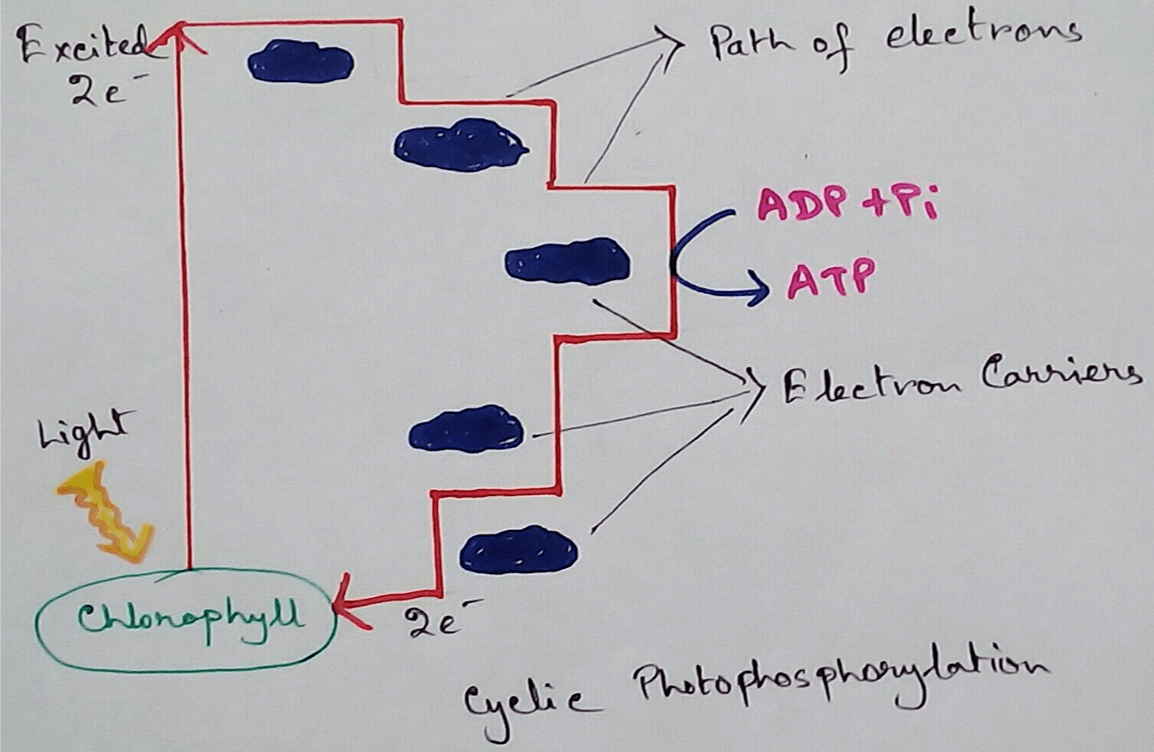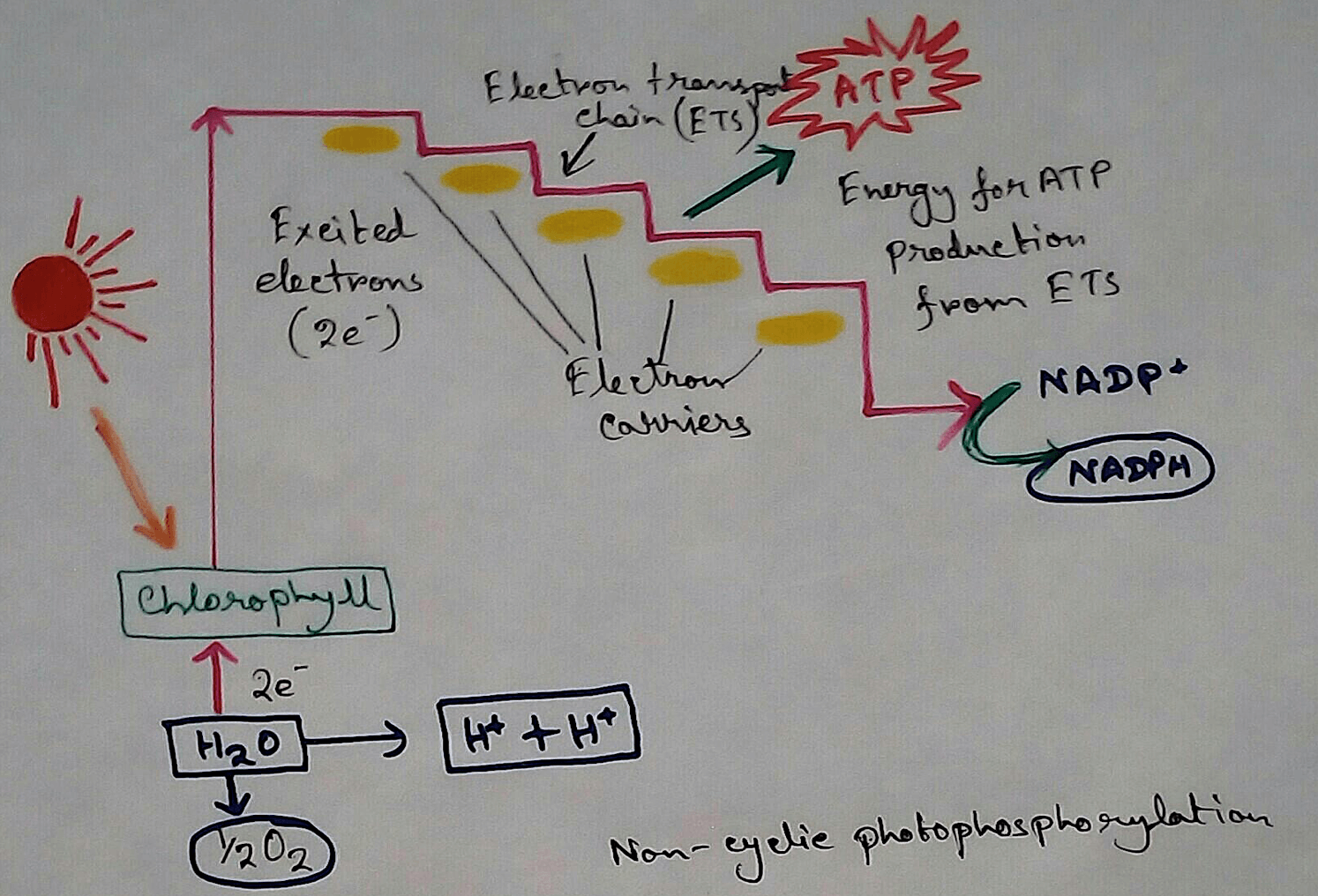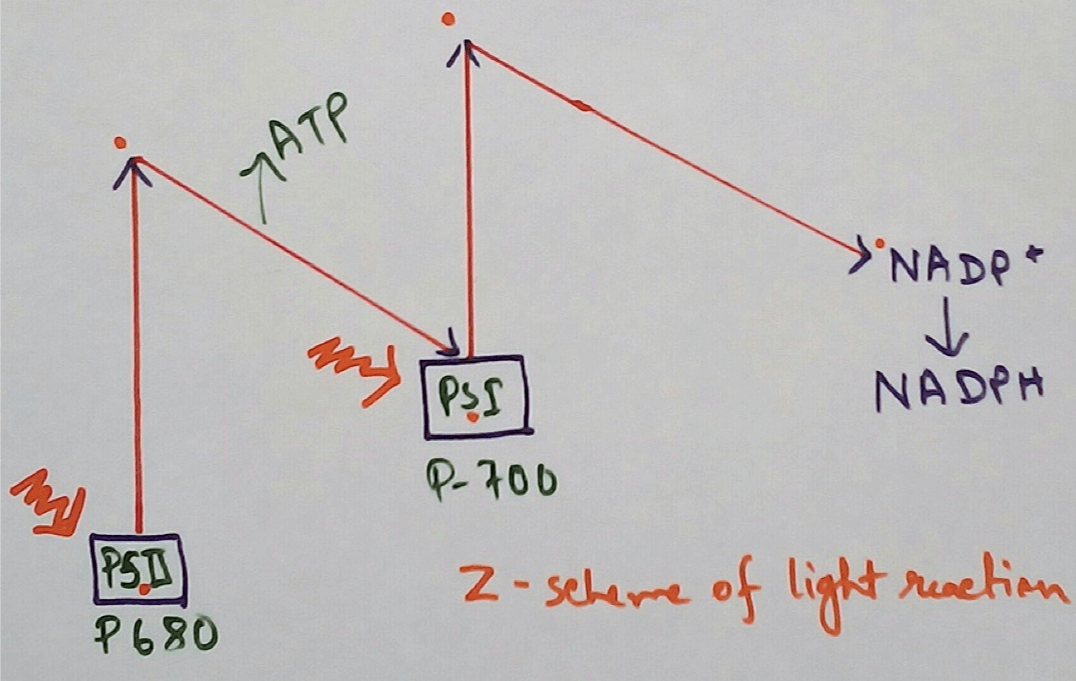Cyclic and Noncyclic Photo-phosphorylation
Photosynthesis is called Redox reaction because carbon dioxide is reduced to glucose and water is oxidised to oxygen.
It is a weakly fluorescent pigment system consisting of chlorophyll B, chlorophyll A of 670, chlorophyll A 680 chlorophyll A 695 and very small amount of chlorophy ll is 700 that consist of reaction centre of PS1. Carotenoids are also observed in blue green algae where chlorophyll B is replaced by phycobilins.
Pigment System 2 - It is one of the strongest fluorescent system that consist of carotenoids, chlorophyll B, chlorophyll A 670 chlorophyll A 680 which are associated to called P 680 and it constitutes the reaction centre called PS2.
Some Major Events of Light Phases -
* Chlorophyll pigment systems are associated with the absorption of quanta of solar energy.
* This energy of solar system is transmitted to the reaction centres of the pigment system such as PS1 p700 and PS2 for P680.
* When the chlorophyll molecule get excited by absorbing the light quanta and passes it into the metastable triplet state, the electron from the outer orbit lost from the chlorophyll molecule which create an electron hole in the same.
* Water molecule which utilises the energy of the electrons and undergoes photolysis liberating hydrogen ions and molecular oxygen. This reductive reaction is termed as Hill reaction as the scientist discovered this reaction in 1937. Ruben and Kamen in 1941 utilised water and proved the finding of the scientist Hill in 1941 .
Water + 2A - → 2AH2 + O2.
* Electrons that are liberated by the excited chlorophyll molecule is accepted by a specific electron Carriers that follow a definite pathway before returning to the chlorophyll molecules. This above process involved a series of redox reaction and some certain specific points whenever the electron is transferred through a major difference of redox potential energy is dissipated and it unite to form ATP by the process called photophosphorylation.
Photophosphorylation - It is of two types - cyclic photophosphorylation and non cyclic photophosphorylation.
Cyclic Photophosphorylation - This process is the cyclic transport of electron from the pigment system 1 back to the same chlorophyll molecule. This process is an incomplete process where the non cyclic photophosphorylation is blocked or the chlorophy ll is get exposed to the light greater than 680 mMicron. The electrons that emitted from the PS1 comes to ferredoxin via a career ferredoxin reducing substance then it passes through cytochrome B6 then cytochrome f and plastocyanin and back to p700. Difference in energy which states between pyridoxine and cytochrome V6 as well as cytochrome B6 and cytochrome F, ADP and pi, unite to form 2 molecules of ATP.
Limitations of Limitations of the Process:
Limitation of these processes are —
* In this process only one photosystem is activated.
* Photolysis of water is not observed so there is no Oxygen gas liberation.
* Formation of a NADPH2 does not take place.
* Blockage of non cyclic photophosphorylation process reduces the rate of carbon dioxide assimilation and there is a fall in the rate of photosynthesis.
Non Cyclic Photophosphorylation -
This is a non cyclic photophosphorylation where involvement and movement of a pair of electrons between the two pigment systems takes place. This reaction is a more accomplished process which explain all the events of photosynthetic light phase and it shows that both the pigment systems PS1 and PS2 are excited by the photon particles of Sunlight. A pair of electrons emitted from PS1 created an electron hole which passes on to Ferredoxin via FRS and ultimately it is received by NADP via the carrier Ferredoxin NADP reductase.
Similarly the electron appear emitted from PS2 are accepted by an unknown carrier and then these electron passes through the plastoquinone, cytochrome B 559, cytochrome f ,plastocyanin and finally to PS1 for filling up the electron hole there. The difference in redox potential between the cytochrome B 559 and cytochrome F causes the first correlation of two ATP molecules forming two molecules of ATP, as a pair of electrons moves at a time. Here the water molecules associated with PS2 which undergoes fertilizers to liberate Oxygen gas and to hydrogen ions which ultimately forms 2 electrons and 2 hydrogen ions. Z - scheme is the pair of electrons of two electron hole of P 680 a strong unidentified incident call Z means Z scheme. The hydrogen ions are accepted by NADP for generating in NADPH2 via the way which is the process called cyclic photophosphorylation because there is an unknown with carrier and also due to the Z like configuration of the reaction scheme. This process causes removal of all the limitations of the cyclic photophosphorylation and is associated with the production of the end products of light phase. End products of light phase are in a NADPH2, ATP and Oxygen gas among which the energy of NADPH2 and ATP are utilised during dark phase and the Oxygen gas is liberated out.
Z scheme the non cyclic photo-phosphorylation scheme that join the PS1 and PS2 is called the Z SCHEME because due to its Z as its configuration is like that and it receives electron from water and transfer it to in NADP.
Difference between Cyclic Photophosphorylation and Noncyclic Photophosphorylation:
Here in cyclic photophosphorylation only one pigment system is activated and and light rays with wavelength above 700 NM are active. In non cyclic photophosphorylation two pigment system active and the light rays both below 680 NM and above 700 NM are active. Photolysis of water and Liberation of oxygen does not take place in cyclical photophosphorylation whereas it is observe in non cyclic photophosphorylation. In cyclic chlorophyll A of PS1 acts as both electron acceptor and donor on the other hand in non cyclic photophosphorylation the electron released by PS2 and is accepted by PS1. In cyclic phosphorylation single electron shows cyclical movement on the other hand a pair of electrons exhibit non cyclic Movement in non-cyclic photophosphorylation. In cyclic photophosphorylation to ATP molecules are synthesized at two different places and in non cyclic photophosphorylation to ATP molecules are synthesized at one.
From Cyclic and Noncyclic Photo-phosphorylation to HOME PAGE
Recent Articles
-
What Is Plasma? | Blood Plasma | Proteins | Nutrients | Cholesterol
Nov 07, 25 10:29 AM
Blood is a mobile fluid which is a connective tissue and is derived from the mesoderm like cell any other connective tissue. Colour of blood is reddish and that flows inside the blood vessels by means… -
Disorders of Respiratory System | Tuberculosis | Pleurisy | Emphysema
Oct 28, 25 11:39 PM
Tuberculosis is very common disease and is caused by a type of bacteria called Mycobacterium tuberculosis. This disease causes different trouble in the respiration and infection of several parts of th… -
Regulation of Respiration | Respiratory Centres | Inspiratory Area |
Oct 14, 25 12:13 AM
Respiratory Centre is the area that controls the rate of respiration and it is observed to be located in medulla oblongata and pons. Respiratory Centre has the following will dispersed components like… -
Explain Transport of Gases | External Respiration | Tissue Respiration
Oct 09, 25 11:35 PM
In humans gaseous exchange is completed in the following ways the steps are - External Respiration or Breathing - Breathing in false taking in of Oxygen and giving out of carbon dioxide in the body. M… -
Kind and Number of Teeth | Location of Teeth in Mouth | Care of Teeth
Sep 11, 25 12:52 AM
Kind and Number of Teeth


















New! Comments
Have your say about what you just read! Leave me a comment in the box below.